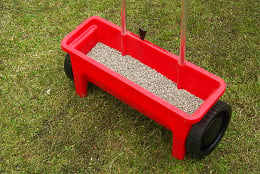
Kentucky bluegrass, a cool-season perennial, is admired for its fine texture and dark green color. But that color will not last long unless it is fertilized. Fertilizer provides supplemental nitrogen, phosphorus, and potassium to the soil, elements that a lawn needs in abundance in order to grow steadily.
Important Note: If you are planting a new lawn from Kentucky Bluegrass seed, please see our separate guide on fertilizing a lawn planted from grass seed.To make your fertilizer applications as effective as possible, follow the tips below.
- Every bag of complete fertilizer will contain 3 numbers that refer to nitrogen, phosphorus, and potassium, in that order. Nitrogen is the most needed element because it influences grass growth and color. Phosphorus is most important for newly established lawns, and becomes less important later on. Potassium is needed more often than phosophorus is, but less often than nitrogen is. Potassium increases the lawn’s tolerance for stress.
- Have a soil test done. The report that comes back will indicate what elements are lacking in the soil and give recommendations for fertilizer applications. On average, Kentucky bluegrass needs 3 to 6 lbs. of nitrogen per 1,000 sq. ft. of lawn, per year. If you don’t have a soil test done, a fertilizer with the ratio of 3-1-2 or 4-1-2 will most likely fit your needs. Keep in mind that a lawn’s fertilizer requirements will depend on how much sunlight and water it receives, how much foot traffic damage it has to repair from, and whether or not you recycle your grass clippings when you mow. Take all of these factors into consideration as you decide on your lawn’s fertilizer needs.
- Pick a fertilizer with some insoluble, or slow-release, nitrogen. When the nitrogen is available to the lawn over time, the grass growth is gradual and strong. Quick grass growth from soluble nitrogen tends to be weak, and limits the equal growth of the lawn’s root system. The fertilizer should contain at least 30 to 50% insoluble nitrogen.
- Time your fertilizer applications appropriately. For a cool-season lawn, you should be fertilizing lightly in the spring and heaviest in the fall. Wait until the lawn is actively growing, and fertilize every 6 to 8 weeks during the growing season, or when the lawn is looking yellow, growing slowly, and becoming susceptible to weeds such as clover.
Okay, you might think. If my Kentucky bluegrass lawn needs an average of 4 lbs. of nitrogen a year, why not apply it all at once? The reason you should never do that is an excess of nitrogen can burn and potentially kill the grass. Never apply more than 1 lb. of pure nitrogen per 1,000 sq. ft. of lawn. To figure out how much of your fertilizer contains 1 lb. of pure nitrogen, divide 100 by the number for nitrogen. For example, if your fertilizer ratio is 18-6-12, you divide 100 by 18 to get approximately 5.5 lbs—this is the total amount of fertilizer you can apply to every 1,000 sq. ft. of lawn.
- Give the lawn a good irrigation a few days before you fertilize, and wait for the leaves to dry completely.
- A drop spreader or rotary spreader can help you to distribute the fertilizer evenly. Put the spreader on the lowest setting, and, taking half of the total fertilizer, spread it across the lawn in a horizontal direction. Then take the other half of the fertilizer and spread it across the lawn in a vertical direction. This will help you to avoid “striping” the lawn, or missing in-between sections.
- Fertilizer is a pollutant, so be very careful with it. Leave a 10 ft. distance between the spreader and any open bodies of water. A little irrigation after the fertilization can help the fertilizer be absorbed in the soil, but too much can cause the fertilizer to be leached into underground water reserves. Use only about ¼” of water. Pick up any stray granules from your driveway and sidewalks as well.


 Okay, you might think. If my Kentucky bluegrass lawn needs an average of 4 lbs. of nitrogen a year, why not apply it all at once? The reason you should never do that is an excess of nitrogen can burn and potentially kill the grass. Never apply more than 1 lb. of pure nitrogen per 1,000 sq. ft. of lawn. To figure out how much of your fertilizer contains 1 lb. of pure nitrogen, divide 100 by the number for nitrogen. For example, if your fertilizer ratio is 18-6-12, you divide 100 by 18 to get approximately 5.5 lbs—this is the total amount of fertilizer you can apply to every 1,000 sq. ft. of lawn.
Okay, you might think. If my Kentucky bluegrass lawn needs an average of 4 lbs. of nitrogen a year, why not apply it all at once? The reason you should never do that is an excess of nitrogen can burn and potentially kill the grass. Never apply more than 1 lb. of pure nitrogen per 1,000 sq. ft. of lawn. To figure out how much of your fertilizer contains 1 lb. of pure nitrogen, divide 100 by the number for nitrogen. For example, if your fertilizer ratio is 18-6-12, you divide 100 by 18 to get approximately 5.5 lbs—this is the total amount of fertilizer you can apply to every 1,000 sq. ft. of lawn.